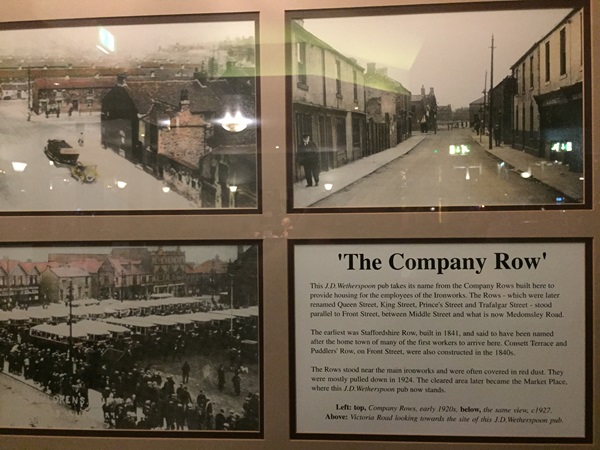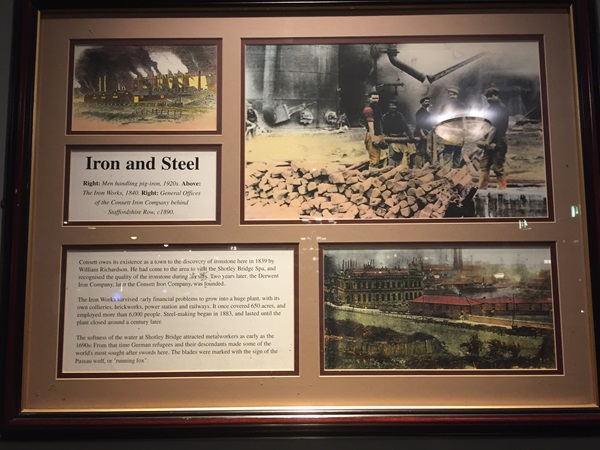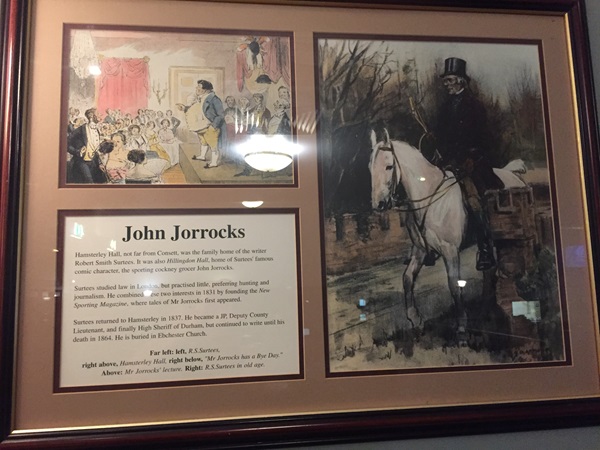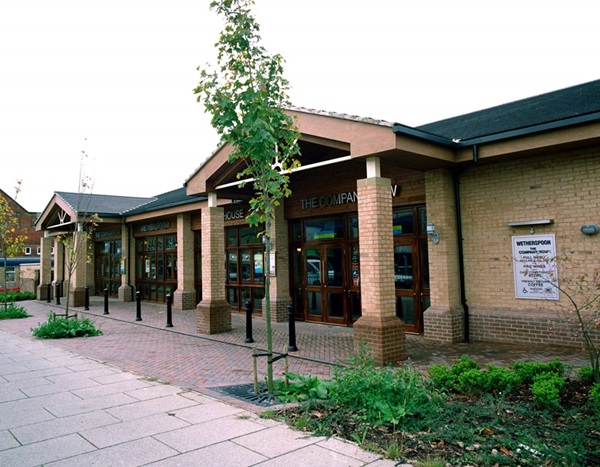Consett came into being after the chance discovery of ironstone, which led to the formation of the Derwent Iron Company, in 1841, which constructed rows of houses, known as Company Rows, for its workers. The first included Staffordshire Terrace and Puddlers’ Row. Other rows – later called Princes Street, King Street and Queen Street – were built parallel to Front Street. They were mostly demolished in 1924 and, in 1936, the site became a market place, which has recently been developed.
Prints and text about The Company Row.

The text reads: This J D Wetherspoon pub takes its name from the Company Row built here to provide housing for the employees of the Ironworks. The Rows – which were later renamed Queen Street, King Street, Prince’s Street and Trafalgar Street – stood parallel to Front Street, between Middle Street and what is now Medomsley Road.
The earliest was Staffordshire Row, built in 1841 and said to have been named after the home town of many of the first workers to arrive here. Consett Terrace and Puddlers’ Row, and Front Street, were also constructed in the 1840s.
The Rows stood near the main ironworks and were often covered in red dust. They were mostly pulled down in 1924. The cleared area later became the Market Place, where this J D Wetherspoon pub now stands.
Left: top, Company Rows, early 1920a, below, the same view, c1927
Above: Victoria Road looking towards the site of this J D Wetherspoon pub.
Prints and text about iron and steel.

The text reads: Consett owes its existence as a town to the discovery of ironstone here in 1839 by William Richardson. He had come to the area to visit the Shotley Bridge Spa, and recognised the quality of ironstone during his stay. Two years later, the Derwent Iron Company, later the Consett Iron Company, was founded.
The Iron Works survived early financial problems to grow into a huge plant, with its own collieries, brickworks, power station and railways. It once covered 650 acres, and employed more than 6,000 people. Steel-making began in 1883, and lasted until the plant closed around a century later.
The softness of the water at Shotley Bridge attracted metalworkers as early as the 1690s. From that time German refugees and their descendants made some of the world’s most sought-after swords here. The blades were marked with the sign of the Passau wolf, or running fox.
Right: Men handling pig-iron, 1920s
Above: The Iron Works, 1840
Right: General offices of the Consett Iron Company behind Staffordshire Row, c1890.
Illustrations and text about John Jorrocks.

The text reads: Hamsterley Hall, not far from Consett, was the family home of the writer Robert Smith Surtees. It was also Hillingdon Hall, home of Surtees’ famous comic character, the sporting cockney grocer John Jorrocks.
Surtees studied law in London, but practised little, preferring hunting and journalism. He combined these two interests in 1831 by founding the New Sporting Magazine, where tales of Mr Jorrocks first appeared.
Surtees returned to Hamsterley in 1837. He became a JP, Deputy County Lieutenant, and finally High Sherriff of Durham, but continued to write until his death in 1864. He is buried in Ebchester Church.
Far left: left, RS Surtees, right above, Hamsterley Hall, right blow, “Mr Jorrocks has a Bye Day”
Above: Mr Jorrocks’ lecture
Right: RS Surtees in old age.
External photograph of the building – main entrance.

If you have information on the history of this pub, then we’d like you to share it with us. Please e-mail all information to: pubhistories@jdwetherspoon.co.uk